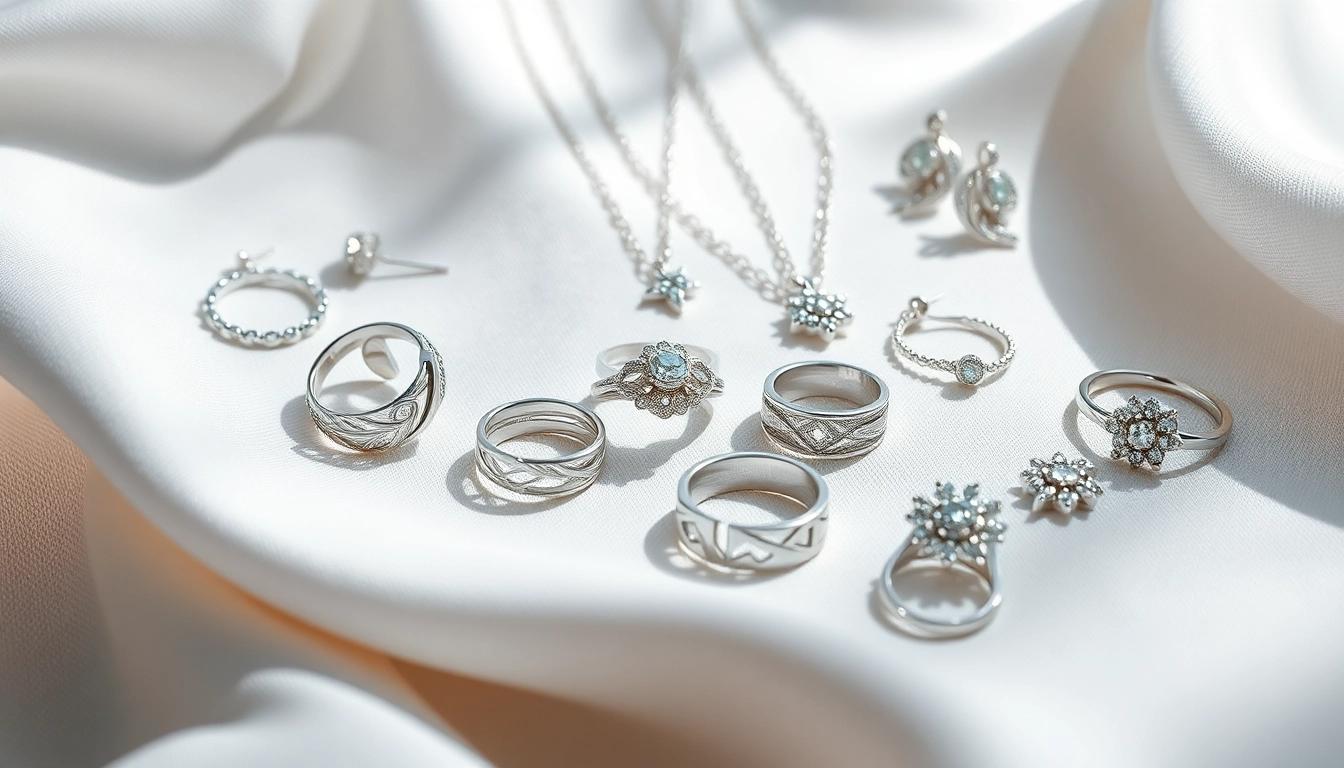The Allure of Silver Jewelry
From ancient civilizations to modern-day fashion, silver jewelry has captivated cultures and individuals alike. Known for its luster and durability, silver has been a favored metal for crafting ornamental pieces that serve both aesthetic and functional purposes. Today, silver jewelry is a popular choice among jewelry enthusiasts, offering a blend of timeless elegance and versatility. This article will explore the intrinsic charm of silver jewelry, its historical and cultural significance, as well as tips on selection, care, personalization, and trends.
1.1 Historical Significance of Silver Jewelry
The history of silver jewelry is rich and diverse, with roots tracing back thousands of years. In ancient Egypt, silver was associated with the moon, symbolizing purity and elegance. The Egyptians crafted intricate jewelry for both the living and the dead, burying their elites with silver pieces to accompany them in the afterlife. Similarly, the Romans used silver to signify wealth and status, creating pieces that were both simple and ornate.
Throughout the Middle Ages, silver became increasingly valuable in Europe, as it was used not only for jewelry but also for coins and tableware. By the Renaissance, silver was a favorite among aristocrats who adorned themselves with elaborate designs featuring gemstones and intricate detailing. The Victorian era further brought silver jewelry into the mainstream, with the introduction of styles like the brooch and locket, remains popular today.
Today, silver continues to hold cultural importance worldwide. Many indigenous tribes in North America traditionally utilize silver in crafting intricate jewelry that reflects their heritage and storytelling traditions. This historical journey illustrates how silver jewelry transcends time and culture, evolving while retaining its allure.
1.2 Types of Silver Jewelry and Their Uses
Silver jewelry comes in numerous forms, each serving unique purposes and appealing to different tastes. Some of the most common types include:
- Rings: Silver rings are versatile, used for engagement, wedding bands, casual fashion rings, and statement pieces. Sterling silver is often preferred for wedding rings due to its strength and beauty.
- Necklaces: Ranging from delicate chains to bold statement pieces adorned with pendants or gemstones, silver necklaces can enhance any outfit.
- Earrings: Silver earrings can vary immensely in design from stud earrings to long dangling ones, adapting to both formal and casual settings.
- Bracelets: Whether simple bangles or intricately designed chain bracelets, silver forms can highlight personal style and flair.
- Pendants and Charms: Silver pendants and charms offer flexibility to express individual personality, often used in customizable jewelry systems.
With such diversity, silver jewelry can be worn in various settings, from daily wear to special occasions, embodying both practicality and a touch of sophistication.
1.3 Cultural Representations of Silver Jewelry
Silver jewelry is deeply embedded in various cultures, often symbolizing status, identity, or spiritual beliefs. In many Indigenous cultures, for example, silver is integral to traditional attire, reflecting community ties and cultural stories. Tlingit and Navajo artisans, for instance, create stunning silver pieces that tell stories of their ancestors and preserve cultural heritage.
In Indian culture, silver jewelry typically signifies auspiciousness and is often worn on special occasions, like weddings. The intricate craftsmanship involved manifests cultural narratives through designs that range from delicate filigree to bold, chunky forms.
Across various societies, silver jewelry also serves as a marker of rites of passage; for instance, it may be gifted for birthdays or graduations, symbolizing growth and new beginnings. Such practices reinforce personal connections and communal bonds through the shared appreciation of artistry and tradition.
Choosing the Right Silver Jewelry
Selecting the ideal piece of silver jewelry can be a fulfilling experience that brings together individual preference and occasion suitability. To ensure satisfaction, it’s essential to consider several key factors.
2.1 Factors to Consider: Style, Occasion, and Skin Tone
When choosing silver jewelry, style should resonate with one’s personal aesthetic—be it contemporary, classic, or bohemian. Consider the occasion as well: delicate pieces may suit casual outings, while bold, statement jewelry may be more appropriate for formal events.
Skin tone is also a vital factor when selecting silver jewelry. Those with warmer undertones generally find that silver complements their style better when paired with yellow-gold accents or stones. Conversely, cooler undertones may shine in silver pieces accented with gems like sapphires or amethysts.
Ultimately, understanding your preferences and the context in which you plan to wear the jewelry will streamline the selection process.
2.2 Tips for Selecting Quality Silver Jewelry
Quality should never be compromised when purchasing silver jewelry. Here are some tips to consider:
- Look for Markings: Authentic sterling silver is typically marked with “925,” indicating that it contains 92.5% silver and is most suitable for jewelry.
- Check the Craftsmanship: Examine the item for signs of quality, such as secure settings for gemstones, smooth surface finishing, and good weight, suggesting solid craftsmanship.
- Choose Reputable Sellers: Buy from established jewelers or brands that demonstrate a commitment to quality and authenticity, ensuring the piece you buy is reliable and lasting.
Investing in quality will not only enhance personal satisfaction but also contribute to the longevity of the jewelry.
2.3 Balancing Trendy vs. Classic Styles
The jewelry market is often driven by trends, but classic silver pieces hold timeless beauty. Striking a balance between trendy and classic can enhance any jewelry collection. Consider investing in a foundational collection of classic pieces, such as plain hoops or a simple silver chain that can be complemented by trendy items like chunky statement rings.
By incorporating both styles, wearers can enjoy the evolving nature of contemporary fashion while maintaining a stable collection that remains relevant.
Care and Maintenance of Silver Jewelry
3.1 Proper Cleaning Techniques
To keep silver jewelry looking its best, regular cleaning is necessary. Avoid harsh chemicals and opt instead for gentle methods. A mixture of warm water and mild soap is effective for routine cleaning. Use a soft cloth or sponge to gently wipe the surface and then rinse well, ensuring no soap resides within the crevices of the jewelry.
For tougher tarnish, a silver polish cloth designed specifically for jewelry can be beneficial, restoring shine without scratching the metal. Avoid using abrasive materials that may cause scratches or dull the surface.
3.2 Storage Solutions for Longevity
How and where silver jewelry is stored significantly influences its longevity. Keep items stored in a dry, cool place, preferably in a fabric-lined jewelry box or pouches to minimize exposure to air and moisture. Anti-tarnish pouches or cloths can further protect against tarnishing, preserving their beauty over time.
When storing multiple pieces together, distinguish them with dividers to prevent scratching or tangling, ensuring they remain in immaculate condition.
3.3 Common Issues and How to Fix Them
Over time, silver jewelry may encounter common issues such as tarnishing, scratches, or loose stones. For tarnished items, homemade solutions like a paste of baking soda and water can gently cleanse the surface. When dealing with scratches, consult professional jewelers for polishing or soldering options.
Regularly check for loose stones or clasps, as minor issues can evolve into major concerns if neglected. Promptly address these with a jeweler to maintain not only the beauty but the integrity of the piece.
Personalizing Your Silver Jewelry
The beauty of silver jewelry lies not only in its aesthetic appeal but also in its capacity for personalization. Personalized jewelry often carries emotional significance and is cherished for years.
4.1 Engraving and Custom Designs
Engraving is a popular method to add a personal touch to silver jewelry. From initials to meaningful dates or quotes, engraving makes a piece unique and meaningful. Many jewelers offer engraving services, allowing clients to transform a regular piece into something special.
Moreover, opting for custom designs enables individuals to specify every facet, from the choice of silver type to intricacies in design. This process can yield bespoke pieces reflecting personal style and stories.
4.2 Combining Silver with Other Materials
Combining silver with various materials, such as leather, gemstones, or wood, creates distinct looks and innovative styles. Leather cuffs adorned with silver studs or rings interspersed with gems show off creativity and personal style preferences.
This fusion of materials not only enhances aesthetic appeal but can also broaden the wearer’s experience with different textures and styles. It’s an excellent way to stand out and express uniqueness in an ever-evolving fashion landscape.
4.3 Creating Family Heirlooms and Gifts
Silver jewelry holds significant sentimental value, making it a perfect choice for family heirlooms. Crafting customized pieces that can be passed down creates a legacy filled with memories and stories. Consider designing a piece with significance in family history or milestones, ensuring its continual appreciation over generations.
Further, silver jewelry comprises exceptional gift options, particularly for milestones such as graduations, anniversaries, or commemorating life events. A piece that reflects the recipient’s style or includes personalized engraving can foster a strong emotional connection, making it a treasured gift.
The Future of Silver Jewelry Trends
As silver jewelry evolves, trends arise that reflect the changing preferences of consumers. Understanding these trends can aid in making informed purchasing decisions for both personal collection and gifting.
5.1 Emerging Designs and Innovations
The silver jewelry industry continuously innovates with the introduction of new styles and technologies. Current trends focus on minimalist designs that emphasize clean lines and simplicity, appealing to contemporary aesthetics.
Additionally, unique textures and finishes, such as hammered or matte surfaces, are gaining popularity, offering fresh takes on classic designs. Wearable art and statement pieces in unexpected forms challenge traditional jewelry expectations, paving the way for the avant-garde.
5.2 Sustainable Practices in Silver Jewelry Production
As consumers become more environmentally conscious, sustainable practices in silver jewelry production are rising. Increasingly brands are prioritizing ethical sourcing and eco-friendly manufacturing processes. Recycled silver is becoming popular, offering a way to reduce waste while still providing high-quality products.
Understanding the ecological impact of jewelry production is likely to become an essential factor in purchasing decisions, leading to a more responsible jewelry industry.
5.3 Predictions for the Next Decade in Silver Jewelry
The future of silver jewelry appears promising, with new innovations likely to emerge. Technology may increasingly influence the design and customization of pieces, such as through 3D printing or augmented reality virtual try-ons.
Moreover, as personal expression remains a strong trend, expect silver jewelry to continue to play a major role in individualized styles, encapsulating personal narratives and cultural identities. With continuous advancements and changing consumer preferences, the silver jewelry industry will adapt while remaining a symbol of art and elegance.
In conclusion, the allure of silver jewelry is deeply rooted in its historical significance, versatility, and cultural representations. By understanding how to choose, care for, and personalize silver jewelry, individuals can enjoy its timeless beauty for years to come. Furthermore, staying attuned to emerging trends allows for an enriching experience that celebrates both tradition and innovation in the world of jewelry.






